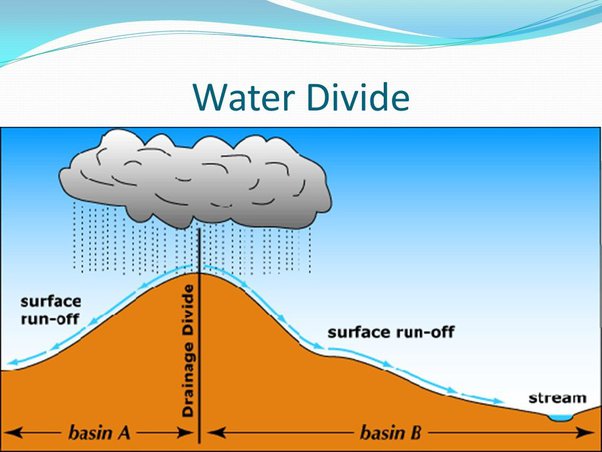Q. How is drainage pattern determined by the water divide?
Ans: A drainage pattern in a landscape is determined by the arrangement of rivers and streams that flow into a larger body of water, such as a river, lake, or ocean. The water divide, also known as a watershed boundary or drainage divide, plays a crucial role in shaping the drainage pattern.
The water divide is an elevated area, such as a ridge or a mountain range, that separates adjacent drainage basins. It acts as a natural boundary, directing the flow of water into distinct drainage patterns.

Here’s how the water divide influences the drainage pattern:
- Flow Direction: Water naturally flows downhill due to gravity. When precipitation falls on both sides of a water divide, it will flow in opposite directions, following the slope of the land. The divide determines the direction in which water will flow into different drainage basins.
- Separation of Drainage Basins: The water divide acts as a separator between adjacent drainage basins. Each basin collects water from its surrounding area and channels it towards a common outlet, usually a river or a lake.
- Formation of Different Patterns: Depending on the arrangement of the land and the water divide, various drainage patterns can form, such as dendritic, radial, rectangular, trellis, and parallel patterns.
- Influence on Topography: The topography of the land, including its elevation, slope, and shape, determines the location and extent of the water divide. High areas, such as mountain ranges, often serve as major divides that direct water into different drainage basins.
- Development of River Networks: Rivers and streams follow the contours of the land as they flow towards the lowest point. The water divide dictates where rivers originate and the paths they take as they meander through the landscape.
- Landforms: The presence of prominent landforms, such as valleys, ridges, and depressions, can influence the location of the water divide and consequently the drainage pattern.
- Landscape Evolution: Over geological time, the water divide can shift due to tectonic activity, erosion, and changes in climate. As the divide changes, it can lead to adjustments in the drainage pattern.
In summary, the water divide acts as a natural barrier that guides the flow of water in a landscape, determining the direction and pattern of drainage. It plays a critical role in shaping the formation of rivers, streams, and other water bodies as they flow into separate drainage basins.
Thanks for reading the answer to the question: How is drainage pattern determined by the water divide?
Read: